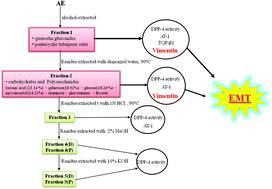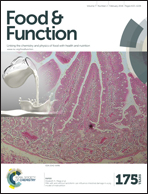Abelmoschus esculentus fractions potently inhibited the pathogenic targets associated with diabetic renal epithelial to mesenchymal transition†
Abstract
Although Abelmoschus esculentus (AE) is known for anti-hyperglycemia, few reports have addressed its target. Our recent studies have focused on diabetic renal epithelial to mesenchymal transition (EMT), which plays a critical role in fibrosis that accompanies increasing vimentin and suggested signals DPP-4/AT-1/TGF-β1. This study aimed to investigate whether AE is useful for preventing diabetic renal EMT. We used a succession of extractions and obtained the corresponding fractions F1–F5, each with its own individual properties: F1 inhibits high glucose-stimulated vimentin, AT-1, TGF-β1, and DPP-4, and recovers E-cadherin in tubular cells; F2 decreases high glucose-induced vimentin, AT-1 and DPP-4; F3–F5 do not reduce the expression of vimentin. Chemical analysis revealed that F1 is rich of flavonoid glycosides especially quercetin glucosides, and pentacyclic triterpene ester. F2 contains a large amount of carbohydrates and polysaccharides composed of uronic acid, galactose, glucose, myo-inositol etc. In conclusion, AE has the potential to serve as an adjuvant for diabetic nephropathy, with F1 and F2 especially deserving further investigation and development.


 Please wait while we load your content...
Please wait while we load your content...